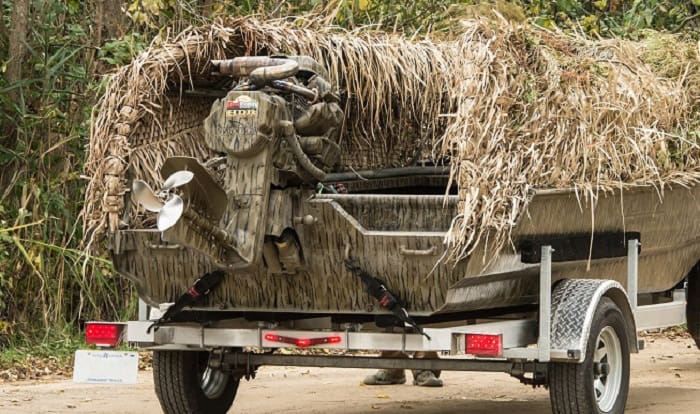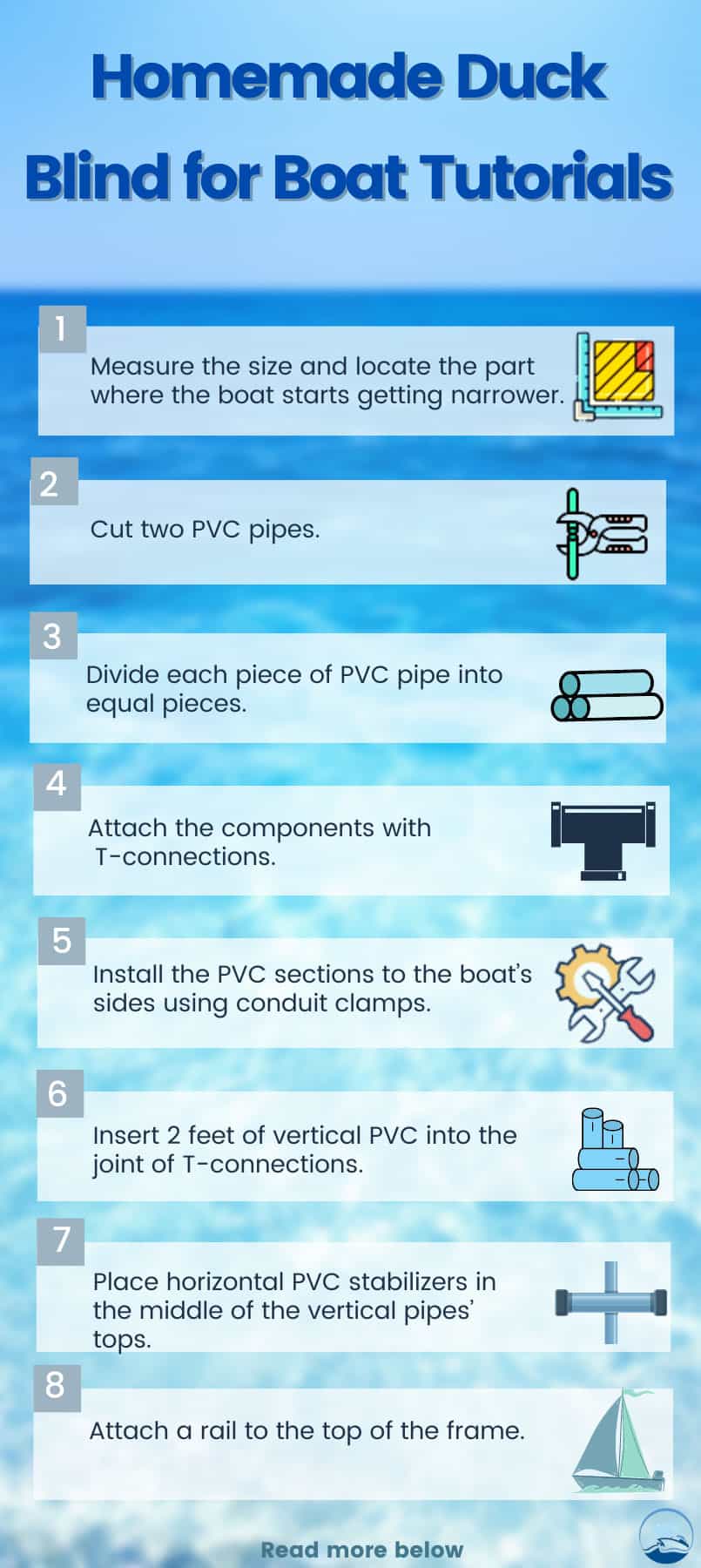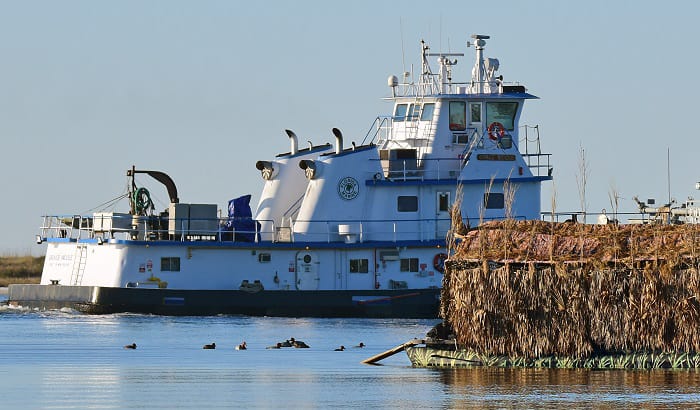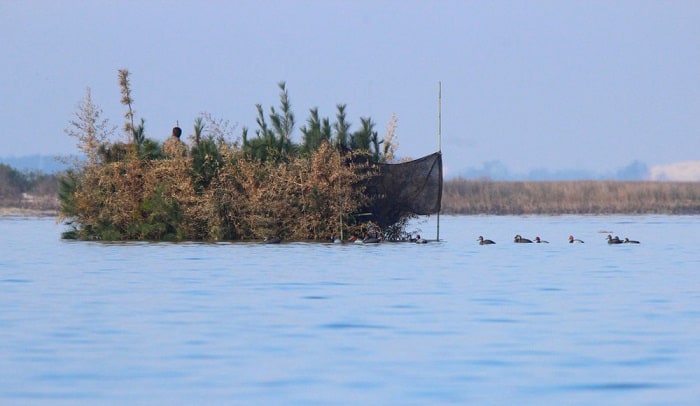One interesting fact about having a vessel is that you can always experience many different boating activities at any time of the year. From freshwater fishing in summer to overnight cruising in spring, numerous on-water adventures are waiting for you to explore.
Nevertheless, since fall and waterfowl season are upon us once again, it is the perfect time for boaters to take part in duck hunting. Hunting from a duck boat may offer a whole new level of excitement to your boat trip, especially with the craft covered by a waterfowl blind. So it would be great if you know how to build a duck blind for a boat.
In short, this article will introduce simple steps that you can use to build your own DIY duck boat blind with only a minimum budget for your hunt, such as:
- Measuring your boat
- Cut two pieces of PVC that fit your boat’s length
- Split PVC pipe in equal pieces
- Glue pieces together using T-connections
- Attach PVS pieces to the sides of your boat
- Add 2 feet vertical pipes into the T-connections
- Place horizontal PVC supports between the tops of the vertical pipes
- Install a top rail to the frame
Moreover, I will also provide proper plans to practice building different duck blinds on numerous types of boats, which help to improve your waterfowl hunting experience. Therefore, stay tuned!
Table of Contents
Setting Up Duck Boat Blind Plan for DIY Customizing
There are many elements that need to be accounted for before you decide to build a duck blind for your boats, such as hiding positions or design and materials. More so, it is necessary to guarantee that these factors are well-prepared before you proceed to set up a duck blind.
1. Choosing a prime location
Choosing a suitable location for your hunt also matters. I recommend selecting a place with plenty of food that can attract waterfowls even in the middle of the winter.
In order to ensure that the fowls stick around, the ideal location should have minimal hunting pressure and an abundance of food. Besides, as the waterfowls are not distracted by the light from your blind, it is clever to make a honey hole for holding ducks during seasons.
Meanwhile, one of the best places to cover up is accessible wetlands. A clear vision, on the other hand, is also necessary. Therefore, you won’t need a lot of covers that will block your view of the ocean and sky.
2. Planning a suitable design and affordable materials
Your duck blind’s design depends on many aspects. For instance, the size of the blind is determined by the number of hunters in the group. Four people can be accommodated in a blind that is six feet wide and 16 feet long. There’s even space for one or two more people.
Make the back wall taller than the front to provide extra headroom, so hunters will not have to squat. Dividers can be used to allocate additional areas for plants while maintaining structural integrity. Still, it would be helpful to ensure the blind is solid and won’t collapse at any time.
Different DIY Duck Blind Plans
Similar to the diversity of boats, there are different types of waterfowl blinds to customize. As we highly recommend you to build your blind in order to save up money, here is a list of simple and low-cost homemade boat duck blinds’ designs to apply on your craft:
1. Rock Solid Duck Boat Blind Kit
Most hunters prefer the design of the rock-solid duck boat blind kit. This boat blind is mostly composed of several conduit bends. The goal in making this frame is to create a structure consisting of two symmetrical triangle shapes.
First, you need to measure the length and the width of your boat. Build a bottom frame based on those measurements and stick it to the craft’s starboard. Then lift the frame up to 45° and install two conduits in the back and the front to create X-structures.
To complete the frame, you’ll need to have 90-degree connectors attached to a long conduit and install them to make a roof. The final step is to cover the frame with camo camouflage.
2. Jon Boat Blind
As popular as Wide-framed boat blind, Jon boat duck blind is often divided into two sides, one side higher than the other. On the outer frame, no conduit is attached, which is normally required by other designs. The frame is mounted to the boat’s structural points using a form of the flange.
On the pipes, a 90-degree connection is used to create a crisp 90-degree edge. This extra piece gets caught in the curve of the conduit, which ends up on the boat’s edge. To finish this phase of the process, you’ll need T connections and 45-degree connectors.
3. Duck Boat Scissor Blind
Working on duck boat scissor blind plans is simple as you don’t need to drill holes in the pedestal base to utilize it. To make the form of the scissors, set up the pipes to get the correct angle. It adds strength to the roof you build above it. The structure is made to withstand severe winds.
Homemade Duck Blind for Boat Tutorials
Instead of purchasing expensive pre-made duck blinds, most duck hunters prefer going the DIY route since it is simple, inexpensive, and customizable to their boats and hunting equipment.
In this part of the article, I will introduce a set of instructions for building a DIY Jon boat duck blind that only costs 150$. Aside from customizing a boat blind based on our idea, you can apply camouflage or other designs on your vessel. Now, let’s have a look at each step:
Step 1
Measure the size of your boat to find the widest and longest part. Continue to measure the boat from the part in front of the motor to the position where it narrows. Then locate the part where the boat starts getting narrower.
Step 2
To match the length of the boat, you’ll need to cut two PVC pipes. Once the length has been determined, convert the measurements to a PVC pipe that has a diameter of 2 in [5.1 cm].
Use a saw to cut the pipe at the created mark, ensuring that the cut is done as straight as feasible. For your frame, you’ll need two same-size pieces of PVC.
Step 3
In this stage, you must divide each piece of PVC pipe into equal pieces. For instance, If your boat’s interior is 9 feet long, you should cut the pipe into six pieces that are 3 feet long.
Step 4
In this step, attach the components with T-connections. Each side of T-connections has a hole on the side as well as the top. These holes allow you to connect numerous pipes.
Gluing the parts together will prevent them from being separated while you’re using it. Still, this step is not necessarily required.
Step 5
Install the PVC sections to the boat’s sides using conduit clamps. To guarantee a secure fit against the boat, conduit clamps may be purchased to match the size of your pipes.
Another thing to keep in mind is that you should never tighten the clamps too near or too low to the boat’s body, since this might cause leaks. As a rule of thumb, measuring from the top edge, keep it 6 inches or less while mounting it.
Step 6
In step six, you have to insert 2 feet of vertical PVC pipes that are prepared beforehand into the joint of T-connections. Then, utilize a hacksaw to cut the PVC pipe into six pieces that are 2 feet long.
To stand up straight against your boat’s walls, the end of each pipe should be placed into the top holes of the T-connections.
Step 7
Place horizontal PVC stabilizers in the middle of the vertical pipes’ tops in this stage. It’s not a good idea to glue the horizontal stabilizers since you won’t be able to detach them easily when you’re done with them.
Remove the horizontal connectors to fold the pipes inside your boat if you need to keep them apart. The conduit connections are actually pretty useful when it comes to spinning pipes and folding blinds that aren’t in use.
Step 8
In this last step, you attach a rail to the top of the frame. This top rail will be constructed with similar size components as the frame’s bottom rail.
So, using your previous measurements, cut six additional PVC pipe pieces to fit the four-way connections with a hacksaw. These pipe portions should cover the boat’s length and reinforce your frame.
Conclusion
Building a DIY duck blind for your boat is not as difficult as you thought. Following these instructions, you can easily customize a unique waterfowl blind that suits your vessel perfectly without worrying about expensive materials and high-cost gadgets. Still, if you are looking for premade yet low-cost duck blinds, I suggest using products like this Portable Blind Hunting. Besides, you also can refer to ways to build a fiberglass boat or build a plywood boat by checking it out.
Did you enjoy the article on how to build a duck blind for a boat? Do you want to add anything else? Please let me know and leave a comment below.

I am passionate about water sports and technical fields, so combining both makes me interested in making contents about boat accessories. With my partner, we went on many trips and sports games together, which led us to think about how we can spread our joys and passions to many people.




